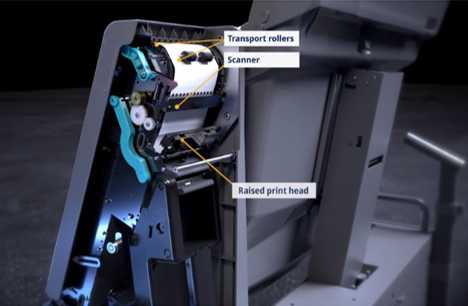Five years ago I described a serious security flaw in the design of all-in-one voting machines made by two competing manufacturers, ES&S and Dominion. These all-in-one machines work like this: the voter indicates choices on a touchscreen; then a printer prints the votes onto a paper ballot; the voter has a chance to review the ballot to make sure the right choices are printed; then the machine sends the ballot past an optical scanner to record and tabulate the votes. Then the mechanism drops the paper into a ballot box where it is saved for recounts or audits.
The reason we have paper (in addition to the optical scanner’s computer-count of the votes) is for our protection, in case the software in the voting machine is hacked. The votes printed on the paper and seen by the voter, can be seen again by the humans performing the recount or audit.
The fatal flaw is having the ballot printer in the same paper path that goes from the voter to the ballot box. That’s because the machinery (printer, scanner, motor-driven rollers) is controlled by the software, and if the software is hacked (replaced by fraudulent software) then the software can make the machinery do things “out of proper order”. In particular, after the voter approves the ballot and touches the “cast-vote” button on-screen, the software is supposed to convey the ballot past the scanner into the ballot box; but hacked software can direct the machinery to take a detour past the printer, where additional votes are printed on to the ballot that the voter did not approve.
This design flaw affects the Dominion ICE and the ES&S ExpressVote and ExpressVoteXL. We explained this problem in section 8 of our paper, Ballot-Marking Devices Cannot Assure the Will of the Voters, by Andrew W. Appel, Richard A. DeMillo, and Philip B. Stark. (Election Law Journal, vol. 19 no. 3, September 2020; non-paywall version here)
It seems that the engineers at ES&S read our paper, because they’ve released a redesigned paper path for the ExpressVoteXL that they claim fixes the problem. They produced this video that states their claim. Unfortunately, they’re wrong: it doesn’t fix the problem.

Their claim is: they have a new “one-way bearing” on their platen roller. It’s mechanically impossible for the “platen roller with one-way bearing” to print while the paper is moving down; mechanically it’s only possible to print while the paper is moving up.
These engineers have failed to “think like the attacker”. Their own software, after the voter has approved what’s printed on the ballot, would only direct the machinery move the paper downward past the scanner and print head. So they fail to consider how hacked software could behave differently. In particular, fraudulent vote-stealing software could move the paper down past the print head, then take the extra step of moving it back up, while printing unauthorized votes on the paper; then move it down again toward the ballot box.
In my opinion, the newly designed paper path, with the “one-way roller”, is just as flawed as the ExpressVote XL’s previous design. Either way, fraudulent software can print additional votes onto the ballot after the last time the voter has had a chance to see the paper. Therefore, ExpressVote XL ballots cannot be considered “voter verified”.
The ExpressVote and ExpressVoteXL have another really big security hole, that their new “fix” also does not fix. The votes that count are the ones encoded in the barcode (which the voter cannot read), not the ones printed in plain text (which the voter can read but usually doesn’t bother to read). The optical scanner reads the barcode, not the plain text. So voters can’t meaningly verify the real votes. Supposedly that could be addressed by an audit of the paper ballots–but many states that use (or are considering) the ExpressVoteXL (New York, Arkansas, Tennessee, …) have very weak audits that wouldn’t reliably catch cheating. And even worse, some election administrators think they can “audit” the paper ballots by running them through a different scanner (from ClearBallot)–but that scanner also reads only the barcode, which the voter has never been able to verify.


Leave a Reply